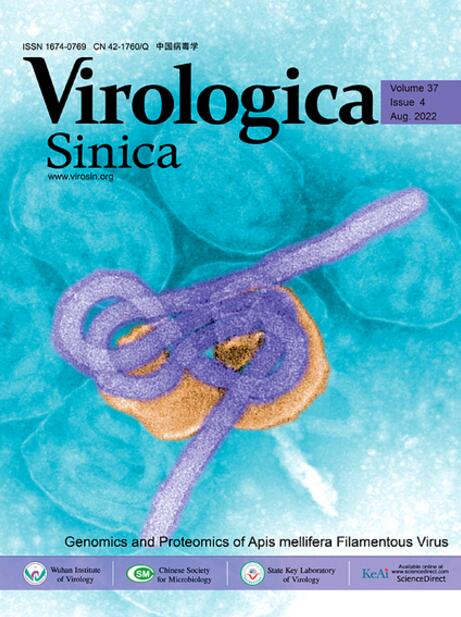低致病性禽流感A/野鸭/韩国/KNU2019-34/2019 (H1N1)病毒具有提高哺乳动物致病性的潜力。
IF 4
3区 医学
Q1 Medicine
引用次数: 0
摘要
流感是一种由流感病毒引起的高度传染性呼吸道传染病,对全世界的公共卫生构成威胁。禽流感病毒(AIVs)有可能通过病毒基因组的突变跨越物种屏障而引起下一次大流行。在这里,我们通过测量小鼠模型肺和肺外器官中的病毒滴度,研究了2018-2019年从韩国和蒙古获得的aiv的致病性。此外,我们还在雪貂模型中评估了aiv的致病性。此外,我们比较了病毒在哺乳动物细胞中的复制能力,以及AIV分离株的受体结合偏好。最后进行遗传分析以确定哺乳动物适应过程中病毒蛋白之间的遗传关系和氨基酸替代。在检测的24株AIV分离株中,A/Mallard/South Korea/KNU2019-34/2019 (KNU19-34;甲型H1N1流感导致小鼠体重严重下降,死亡率高。病毒在肺、肾和心脏中复制。重要的是,感染knu19 -34的雪貂在鼻洗液和肺部都显示出高病毒载量。KNU19-34在A549中快速复制,并优先与人α2,6-链唾液酸结合,而不是与鸟α2,3-链唾液酸结合,与大流行的A/California/04/2009 (H1N1)病毒相似。2015 - 2018年,KNU19-34基因片段分布在埃及和亚洲谱系中,与小鼠非致病性H1N1 AIV分离株相比,该病毒存在多个氨基酸替换。总的来说,这些数据表明KNU19-34具有人畜共患的潜力,并且可能发生新的突变,导致哺乳动物适应。本文章由计算机程序翻译,如有差异,请以英文原文为准。
A low pathogenic avian influenza A/Mallard/South Korea/KNU2019-34/2019 (H1N1) virus has the potential to increase the mammalian pathogenicity
Influenza, a highly contagious respiratory infectious disease caused by an influenza virus, is a threat to public health worldwide. Avian influenza viruses (AIVs) have the potential to cause the next pandemic by crossing the species barrier through mutation of viral genome. Here, we investigated the pathogenicity of AIVs obtained from South Korea and Mongolia during 2018–2019 by measuring viral titers in the lungs and extrapulmonary organs of mouse models. In addition, we assessed the pathogenicity of AIVs in ferret models. Moreover, we compared the ability of viruses to replicate in mammalian cells, as well as the receptor-binding preferences of AIV isolates. Genetic analyses were finally performed to identify the genetic relationships and amino acid substitutions between viral proteins during mammalian adaptation. Of the 24 AIV isolates tested, A/Mallard/South Korea/KNU2019-34/2019 (KNU19-34; H1N1) caused severe bodyweight loss and high mortality in mice. The virus replicated in the lungs, kidneys, and heart. Importantly, KNU19-34-infected ferrets showed high viral loads in both nasal washes and lungs. KNU19-34 replicated rapidly in A549 and bound preferentially to human like α2,6-linked sialic acids rather than to avian-like α2,3-linked sialic acids, similar to the pandemic A/California/04/2009 (H1N1) strain. Gene segments of KNU19-34 were distributed in Egypt and Asia lineages from 2015 to 2018, and the virus had several amino acid substitutions compared to H1N1 AIV isolates that were non-pathogenic in mice. Collectively, the data suggest that KNU19-34 has zoonotic potential and the possibility of new mutations responsible for mammalian adaptation.
求助全文
通过发布文献求助,成功后即可免费获取论文全文。
去求助
来源期刊

Virologica Sinica
Biochemistry, Genetics and Molecular Biology-Molecular Medicine
CiteScore
7.70
自引率
1.80%
发文量
3149
期刊介绍:
Virologica Sinica is an international journal which aims at presenting the cutting-edge research on viruses all over the world. The journal publishes peer-reviewed original research articles, reviews, and letters to the editor, to encompass the latest developments in all branches of virology, including research on animal, plant and microbe viruses. The journal welcomes articles on virus discovery and characterization, viral epidemiology, viral pathogenesis, virus-host interaction, vaccine development, antiviral agents and therapies, and virus related bio-techniques. Virologica Sinica, the official journal of Chinese Society for Microbiology, will serve as a platform for the communication and exchange of academic information and ideas in an international context.
Electronic ISSN: 1995-820X; Print ISSN: 1674-0769
 求助内容:
求助内容: 应助结果提醒方式:
应助结果提醒方式:


